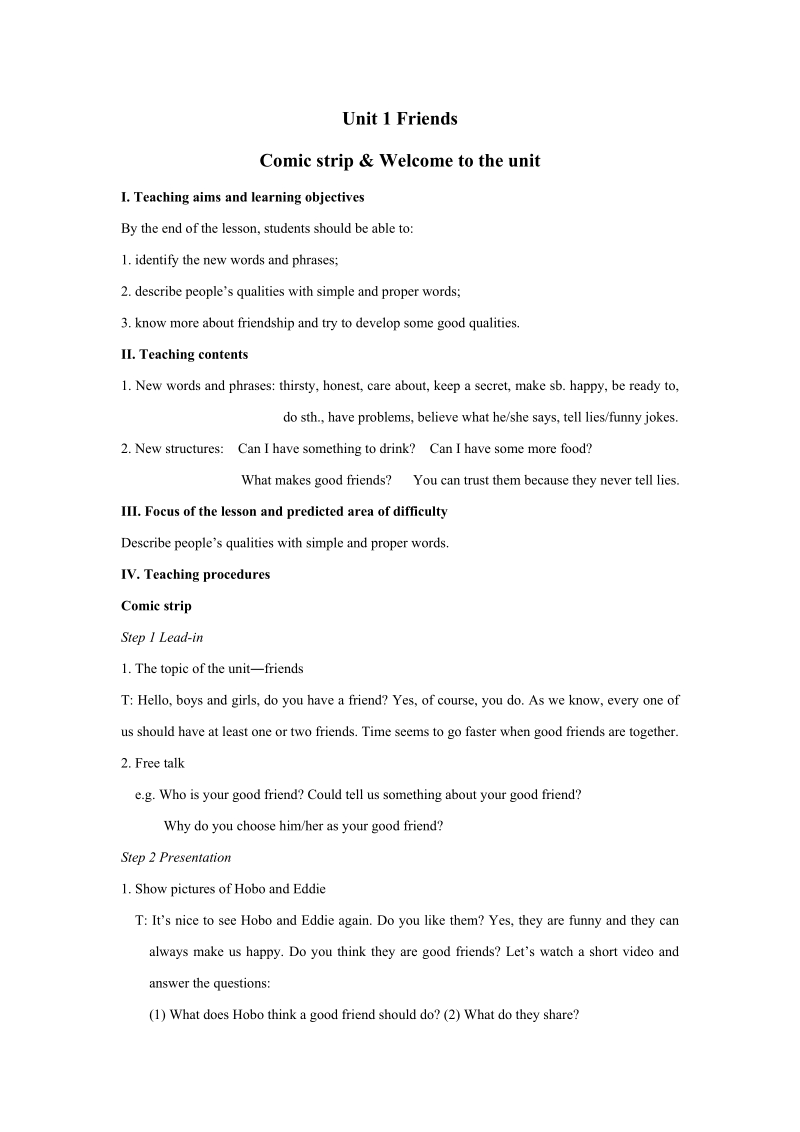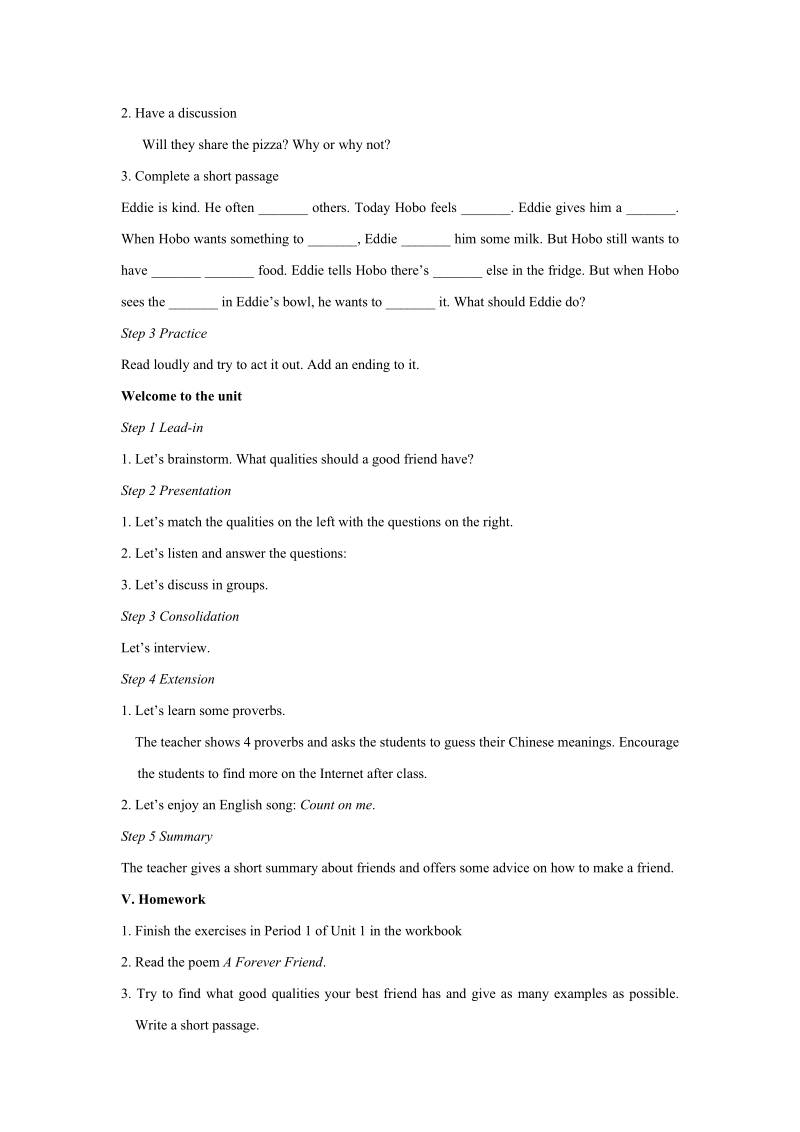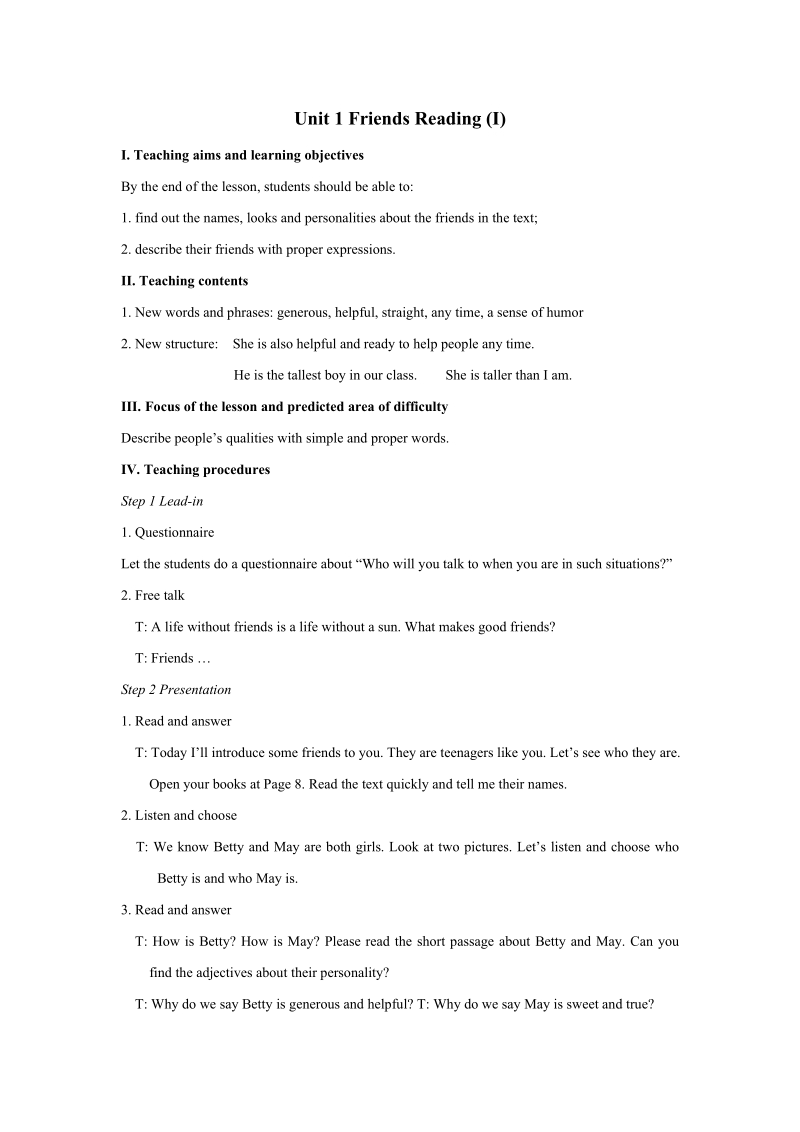 2019年秋牛津译林版八年级英语上册Unit1全英文教案
2019年秋牛津译林版八年级英语上册Unit1全英文教案
《2019年秋牛津译林版八年级英语上册Unit1全英文教案》由会员分享,可在线阅读,更多相关《2019年秋牛津译林版八年级英语上册Unit1全英文教案(14页珍藏版)》请在七七文库上搜索。
1、Unit 1 Friends Comic strip 2. describe peoples qualities with simple and proper words;3. know more about friendship and try to develop some good qualities.II. Teaching contents1. New words and phrases: thirsty, honest, care about, keep a secret, make sb. happy, be ready to, do sth., have problems, b
2、elieve what he/she says, tell lies/funny jokes. 2. New structures: Can I have something to drink? Can I have some more food?What makes good friends? You can trust them because they never tell lies.III. Focus of the lesson and predicted area of difficultyDescribe peoples qualities with simple and pro
3、per words.IV. Teaching proceduresComic stripStep 1 Lead-in1. The topic of the unitfriends T: Hello, boys and girls, do you have a friend? Yes, of course, you do. As we know, every one of us should have at least one or two friends. Time seems to go faster when good friends are together. 2. Free talke
4、.g. Who is your good friend? Could tell us something about your good friend?Why do you choose him/her as your good friend? Step 2 Presentation1. Show pictures of Hobo and EddieT: Its nice to see Hobo and Eddie again. Do you like them? Yes, they are funny and they can always make us happy. Do you thi
5、nk they are good friends? Lets watch a short video and answer the questions:(1) What does Hobo think a good friend should do? (2) What do they share?2. Have a discussionWill they share the pizza? Why or why not? 3. Complete a short passageEddie is kind. He often _ others. Today Hobo feels _. Eddie g
6、ives him a _. When Hobo wants something to _, Eddie _ him some milk. But Hobo still wants to have _ _ food. Eddie tells Hobo theres _ else in the fridge. But when Hobo sees the _ in Eddies bowl, he wants to _ it. What should Eddie do? Step 3 PracticeRead loudly and try to act it out. Add an ending t
7、o it.Welcome to the unitStep 1 Lead-in1. Lets brainstorm. What qualities should a good friend have? Step 2 Presentation1. Lets match the qualities on the left with the questions on the right.2. Lets listen and answer the questions: 3. Lets discuss in groups.Step 3 ConsolidationLets interview. Step 4
8、 Extension1. Lets learn some proverbs.The teacher shows 4 proverbs and asks the students to guess their Chinese meanings. Encourage the students to find more on the Internet after class. 2. Lets enjoy an English song: Count on me.Step 5 SummaryThe teacher gives a short summary about friends and offe
9、rs some advice on how to make a friend.V. Homework1. Finish the exercises in Period 1 of Unit 1 in the workbook2. Read the poem A Forever Friend.3. Try to find what good qualities your best friend has and give as many examples as possible. Write a short passage.Unit 1 Friends Reading (I) I. Teaching
10、 aims and learning objectivesBy the end of the lesson, students should be able to:1. find out the names, looks and personalities about the friends in the text;2. describe their friends with proper expressions.II. Teaching contents1. New words and phrases: generous, helpful, straight, any time, a sen
11、se of humor2. New structure: She is also helpful and ready to help people any time.He is the tallest boy in our class. She is taller than I am.III. Focus of the lesson and predicted area of difficultyDescribe peoples qualities with simple and proper words.IV. Teaching proceduresStep 1 Lead-in1. Ques
12、tionnaireLet the students do a questionnaire about “Who will you talk to when you are in such situations?”2. Free talkT: A life without friends is a life without a sun. What makes good friends? T: Friends Step 2 Presentation1. Read and answerT: Today Ill introduce some friends to you. They are teena
13、gers like you. Lets see who they are. Open your books at Page 8. Read the text quickly and tell me their names.2. Listen and chooseT: We know Betty and May are both girls. Look at two pictures. Lets listen and choose who Betty is and who May is.3. Read and answerT: How is Betty? How is May? Please r
14、ead the short passage about Betty and May. Can you find the adjectives about their personality?T: Why do we say Betty is generous and helpful? T: Why do we say May is sweet and true? 4. Read and fill in the tableName Looks Personality Other informationBettyMay5. Listen and repeat Listen to the recor
15、d of Part 1 and Part 3 and repeat sentence by sentence. 6. (1) Listen to the record and repeat sentence by sentence. (2) Retell the passage according to the table above.7. Read and answerRead Part 2 and answer the following questions.(1) How tall is Max?(2) Does Max look lovely when he wears small r
16、ound glasses?(3) How do we feel when we are with Max? Why?(4) Do Maxs legs fit well under his desk?(5) What happens to him when Max walks past the desk?Step 3 Extension1. Pair workHave a discussion about “Who do you want to choose as your best friend, Betty, Max or May? Why?” in pairs. 2. SummaryTea
17、cher gives a short summary.V. Homework1. Listen to the tape and repeat after it three times;2. Finish the exercises B1 and B2 on Page 9;3. Write a passage about your best friend.Unit 1 Friends Reading (II)I. Teaching aims and learning objectives1. introduce Betty, Max and May with the help of a mind
18、 map;2. use the key words and expressions to express their own ideas;3. write about a person they are familiar with in detail;4. know how to organize a good paragraph with a topic sentence and supporting details in a logic order.II. Teaching contents1. New words and phrases: fit, walk past, knock on
19、to, worry, give her seat to someone in need, have a good voice, wear small round glasses, bored 2. Know how to organize a good paragraph with a topic sentence and supporting details.IV. Teaching proceduresStep 1 Lead-inShow three pictures of Betty, Max and May and ask students to describe their look
20、s. Point out that when describing peoples looks, we should pay attention to their figures and distingushing features.Step 2 Mind-mapping1. Help the students to recall the details by mind-mapping.2. Ask the students to introduce Betty, Max and May by mind-mapping.Step 3 Language focus1. make sb. do s
21、th. 2. Read more descriptions of a person and share them in the class.Unit 1 Friends GrammarI. Teaching aims and learning objectivesBy the end of the lesson, students should be able to:1. know when to use comparatives and superlatives;2. use comparatives and superlatives correctly; 3. compare people
22、 or things.II. Teaching contents1. New words and phrases: height, slimmer, worse, worst;2. New structure: We use “comparatives + than” to compare people or things.We use “the + superlatives” to compare three or more people or things.III. Focus of the lesson and predicted area of difficulty1. Introdu
23、ce the structure of comparative and superlative adjectives;2. Change the adjectives into comparative and superlative forms.IV. Teaching proceduresStep 1 Lead-in1. Try to describe. Describe two girls appearances.2. Try to compareShow a table about two girls appearance. Lead the students to compare th
24、em. Alice is shorter than Lucy. Lucy is taller than Alice.Alices eyes are bigger than Lucys. Lucys eyes are smaller than Alices.Alices hair is longer than Lucys. Lucys hair is shorter than Alices.Step 2 Presentation of comparative adjectives1. Try to work out the ruleAsk the students to read these s



- 配套讲稿:
如PPT文件的首页显示word图标,表示该PPT已包含配套word讲稿。双击word图标可打开word文档。
- 特殊限制:
部分文档作品中含有的国旗、国徽等图片,仅作为作品整体效果示例展示,禁止商用。设计者仅对作品中独创性部分享有著作权。
- 关 键 词:
- 2019 牛津 译林版八 年级 英语 上册 Unit1 英文 教案
 七七文库所有资源均是用户自行上传分享,仅供网友学习交流,未经上传用户书面授权,请勿作他用。
七七文库所有资源均是用户自行上传分享,仅供网友学习交流,未经上传用户书面授权,请勿作他用。



 浙公网安备33030202001339号
浙公网安备33030202001339号
链接地址:https://www.77wenku.com/p-82060.html